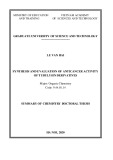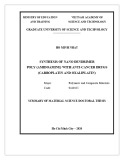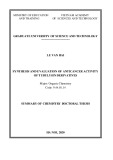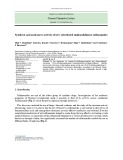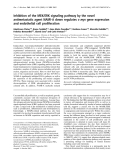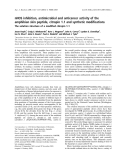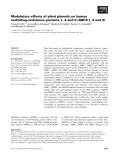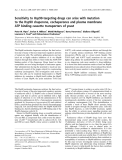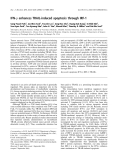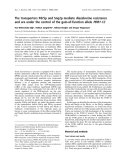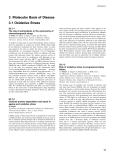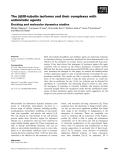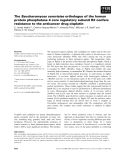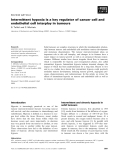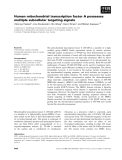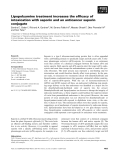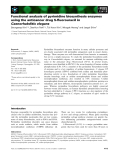
Anti-cancer
-
Aim of the thesis: Synthesis of several derivatives and tubulysin analogues with the replacement of the amino acid methylpipecolic (Mep) at the N-terminal, replacing N,O-acetyl group by methyl group, and researching the role of tubuphenylalanine (Tup) group at the C-terminal.
 26p
26p  extraenglish
extraenglish
 24-05-2021
24-05-2021
 18
18
 4
4
 Download
Download
-
Objective: Study on synthesis of nano dendrimer PAMAM with anticancer drugs carboplatin (CAR) and oxaliplatin (OXA) to reduce the toxicity of the drug to normal cells and improve the effectiveness on cancer cell destruction by increasing solubility, increasing drug storage capacity, targeting drugs passively.
 27p
27p  extraenglish
extraenglish
 24-05-2021
24-05-2021
 19
19
 4
4
 Download
Download
-
Synthesis of several derivatives and tubulysin analogues with the replacement of the amino acid methylpipecolic (Mep) at the N-terminal, replacing N,O-acetyl group by methyl group, and researching the role of tubuphenylalanine (Tup) group at the C-terminal .
 26p
26p  capheviahe27
capheviahe27
 23-02-2021
23-02-2021
 19
19
 5
5
 Download
Download
-
To evaluate the anticancer effect of measles vaccine virus in combination with Nimotuzumab in vitro. To evaluate the anticancer effect of measles vaccine virus in combination with Nimotuzumab on nude mouse model with head and neck cancer (in vivo).
 30p
30p  angicungduoc6
angicungduoc6
 21-07-2020
21-07-2020
 35
35
 4
4
 Download
Download
-
Obtained by the interaction of 2-amino-3,3-dichloroacrylonitrile and chlorosulphonyl isocyanate (Z)-(5-(dichloromethylene)-2-oxoimidazolidin-4-ylidene)sulfamoyl chloride reacts easily with excess of the aliphatic amine to form new (Z)-N-(5-(dichloromethylene)-2-oxoimidazolidin-4-ylidene)-N'-substituted sulfonamides.
 12p
12p  tocectocec
tocectocec
 25-05-2020
25-05-2020
 10
10
 1
1
 Download
Download
-
Nuclear factor erythroid-2 related factor 2 (Nrf2) is a crucial transcription factor that regulates the expression of defensive antioxidants and detoxification enzymes in cells. In a previous study, we showed that expression of the Nrf2 gene is regulated by an epigenetic modification. Rauvolfia verticillata, a traditional Chinese herbal medicine widely used in China, possesses anticancer and antioxidant effects. In this study, we investigated how Nrf2 is epigenetically regulated by reserpine, the main active component in R. verticillata, in mouse skin epidermal JB6 P+ cells.
 11p
11p  caothientrangnguyen
caothientrangnguyen
 09-05-2020
09-05-2020
 17
17
 2
2
 Download
Download
-
Hexadecylphosphocholine (HePC) is a synthetic lipid rep-resentative of a new group of antiproliferative agents, alkylphosphocholines (APC), which are promising candi-dates in anticancer therapy. Thus we have studied the action of HePC on the human hepatoblastoma cell line HepG2, which is frequently used as a model for studies into hepatic lipid metabolism.
 7p
7p  research12
research12
 23-04-2013
23-04-2013
 42
42
 1
1
 Download
Download
-
Imidazolium trans-imidazoledimethyl sulfoxide-tetrachlo-roruthenate (NAMI-A) is a novel ruthenium-containing experimental antimetastatic agent. Compelling evidence ascribes apivotal role toendothelial cells in theorchestration of tumor angiogenesis and metastatic growth, suggesting antiangiogenic therapy as an attractive approach for anticancer treatment.
 10p
10p  tumor12
tumor12
 22-04-2013
22-04-2013
 44
44
 2
2
 Download
Download
-
A large number of bioactive peptides have been isolated from amphibian skin secretions. These peptides have a variety of actions including antibiotic and anticancer acti-vities and the inhibition of neuronal nitric oxide synthase. We have investigated the structure–activity relationship of citropin 1.1, a broad-spectrum antibiotic and anticancer agent that also causes inhibition of neuronal nitric oxide synthase, by making a number of synthetically modified analogues.
 13p
13p  tumor12
tumor12
 20-04-2013
20-04-2013
 37
37
 3
3
 Download
Download
-
Plant flavonoids are polyphenolic compounds, commonly found in vegeta-bles, fruits and many food sources that form a significant portion of our diet. These compounds have been shown to interact with several ATP-bind-ing cassette transporters that are linked with anticancer and antiviral drug resistance and, as such, may be beneficial in modulating drug resistance. This study investigates the interactions of six common polyphenols; querce-tin, silymarin, resveratrol, naringenin, daidzein and hesperetin with the multidrug-resistance-associated proteins, MRP1, MRP4 and MRP5. ...
 16p
16p  fptmusic
fptmusic
 12-04-2013
12-04-2013
 40
40
 2
2
 Download
Download
-
The Hsp90 molecular chaperone catalyses the final activa-tion step of many of themost important regulatory proteins of eukaryotic cells. The antibiotics geldanamycin and rad-icicol act as highly selective inhibitors of in vivo Hsp90 function through their ability to bindwithin the ADP/ATP binding pocket of the chaperone. Drugs based on these compounds are now being developed as anticancer agents, their administration having the potential to inactivate sim-ultaneously several of the targets critical for counteracting multistep carcinogenesis. ...
 7p
7p  fptmusic
fptmusic
 12-04-2013
12-04-2013
 44
44
 3
3
 Download
Download
-
Tumor necrosis factor (TNF)-related apoptosis-inducing ligand (TRAIL) is amember of theTNFfamilyandapotent inducer of apoptosis. TRAIL has been shown to effectively limit tumor growthin vivowithout detectable cytotoxic side-effects. Interferon (IFN)-coften modulates the anticancer activities of TNF family members including TRAIL. How-ever, little is known about the mechanism. To explore the mechanism, A549, HeLa, LNCaP, Hep3B andHepG2 cells were pretreated with IFN-c, and then exposed to TRAIL.
 7p
7p  awards
awards
 05-04-2013
05-04-2013
 48
48
 4
4
 Download
Download
-
The spontaneous acquisition of resistance to a variety of unrelated cytotoxic compounds has important implications in medical treatment of infectious diseases and anticancer therapy. In the yeast Saccharomyces cerevisiaethis pheno-menon is caused by overexpression of membrane efflux pumps and is called pleiotropic drug resistance. We have found that allelic forms of the genes for the transcription activators Pdr1p and Pdr3p, designated PDR1-12and PDR3-33,respectively, mediate resistance to diazaborine....
 8p
8p  dell39
dell39
 03-04-2013
03-04-2013
 38
38
 3
3
 Download
Download
-
A number of drugs used in cancer chemotherapy induce oxidative stress by generation of oxygen free radicals (ROS) which might be an alternative mechanism for their cytotoxic effect via indu-cing apoptosis. In order to clarify the roles of antioxidants in chemotherapy, we investigated Quercetin (3,3’,4’,5,7-pentahyd-roxyflavone) and N-acetylcysteine (NAC) in different cell types treated with anticancer drugs. We studied cytotoxic activity of Topotecan alone and/or in combination with Quercetin in two human breast cancer cell lines, MCF-7 and MDA-MB-231. ...
 7p
7p  inspiron33
inspiron33
 26-03-2013
26-03-2013
 56
56
 4
4
 Download
Download
-
Both microtubule destabilizer and stabilizer agents are important molecules in anticancer therapy. In particular, paclitaxel has been demonstrated to be effective for the treatment of ovarian, breast, and nonsmall cell lung carci-nomas. It has been shown that emergence of resistance against this agent correlates with an increase in the relative abundance of tubulin isoform bIII and that the more recently discovered IDN5390 can be effectively used once resistance has emerged.
 10p
10p  inspiron33
inspiron33
 25-03-2013
25-03-2013
 50
50
 4
4
 Download
Download
-
The anticancer agents cisplatin and oxaliplatin are widely used in the treat-ment of human neoplasias. A genome-wide screen inSaccharomyces cere-visiae previously identified PPH3and PSY2among the top 20 genes conferring resistance to these anticancer agents. The mammalian ortho-logue of Pph3p is the protein serine⁄threonine phosphatase Ppp4c, which is found in high molecular mass complexes bound to a regulatory subunit R2.
 13p
13p  inspiron33
inspiron33
 25-03-2013
25-03-2013
 39
39
 4
4
 Download
Download
-
Solid tumours are complex structures in which the interdependent relation-ship between tumour and endothelial cells modulates tumour development and metastasis dissemination. The tumour microenvironment plays an important role in this cell interplay, and changes in its features have a major impact on tumour growth as well as on anticancer therapy respon-siveness.
 12p
12p  galaxyss3
galaxyss3
 07-03-2013
07-03-2013
 47
47
 2
2
 Download
Download
-
The mitochondrial transcription factor A (TFAM) is a member of a high-mobility group (HMG) family represented mostly by nuclear proteins. Although nuclear localization of TFAM has been demonstrated in some tumors and after treatment of tumor cells with anticancer drugs, the signifi-cance of these observations has not been fully elucidated.
 12p
12p  media19
media19
 05-03-2013
05-03-2013
 37
37
 2
2
 Download
Download
-
Saporin is a type I ribosome-inactivating protein that is often appended with a cell-binding domain to specifically target and kill cancer cells. Uroki-nase plasminogen activator (uPA)-saporin, for example, is an anticancer toxin that consists of a chemical conjugate between the human uPA and native saporin.
 12p
12p  media19
media19
 04-03-2013
04-03-2013
 25
25
 2
2
 Download
Download
-
Pyrimidine biosynthesis enzymes function in many cellular processes and are closely associated with pyrimidine antagonists used in cancer chemo-therapy. These enzymes are well characterized from bacteria to mammals, but not in a simple metazoan. To study the pyrimidine biosynthesis path-way inCaenorhabditis elegans, we screened for mutants exhibiting resis-tance to the anticancer drug 5-fluorouracil (5-FU).
 12p
12p  vinaphone15
vinaphone15
 25-02-2013
25-02-2013
 52
52
 2
2
 Download
Download
CHỦ ĐỀ BẠN MUỐN TÌM








